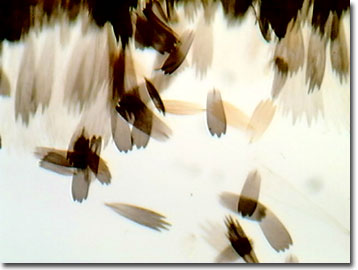Butterfly Wing Scale Digital Image Gallery
Malachite Butterfly
Malachite is a semi-precious green gemstone and the malachite butterfly is so-named because of the pale green translucent patches visible on the upper sides of its wings. Sexual dimorphism is so pronounced in malachite butterflies that the larger and more lightly colored females are sometimes mistakenly placed in different subspecies than the males of their populations.

Although its hind wings feature tails, the malachite butterfly is not in the swallowtail butterfly family. Instead, malachites are members of the brush-footed butterfly family and are scientifically described as Siproeta stelenes. In South and Central America, the malachite butterfly frequents subtropical evergreen and deciduous forests, while in southern Florida, mango, avocado, and citrus orchards are its regular haunts. In Jamaica and Cuba, malachite butterflies may be observed on mountain slopes sipping nectar from the white flowers of coffee plants. In fact, malachites are considered one of the most common butterflies of coffee, tea, and cocoa plantations. Sometimes the fast, powerful, fliers will feed all day long, soaring to great heights to visit their favorite blooms.
Malachite butterflies are frequently accused of impersonating other butterfly species. Some lepidopterists claim that malachite butterflies are mimics of the scare bamboo page butterfly. However, their microhabitats differ, which would decrease the advantage of the mimicry. Such a strategy might be successful against birds that move easily between habitat types, but cannot be as effective with less mobile predators. Other lepidopterists argue that malachite adults mimic the toxic zebra longwing butterflies and, when flying, convey their image, only faster.
Adult female malachite butterflies lay their small, dark green eggs singly on the newest growth of host plant leaves. The plants they choose are often petunias, shrimp plants, cafetin and black-eyed Susans. The small, young caterpillars feed and rest on the host leaves from below. As they mature, the malachite larvae grow into a rich, velvety black with red bristles between their body segments and spined horns on their heads. The red and black coloring helps identify the caterpillars as unpalatable to potential predators. When disturbed, the caterpillars spit a green fluid and the spines of the older larvae create a rash upon human skin when touched.
Contributing Authors
Cynthia D. Kelly, Shannon H. Neaves, Laurence D. Zuckerman, and Michael W. Davidson - National High Magnetic Field Laboratory, 1800 East Paul Dirac Dr., The Florida State University, Tallahassee, Florida, 32310.
BACK TO THE BUTTERFLY WING SCALE IMAGE GALLERY
BACK TO THE DIGITAL IMAGE GALLERIES
Questions or comments? Send us an email.
© 1995-2025 by Michael W. Davidson and The Florida State University. All Rights Reserved. No images, graphics, software, scripts, or applets may be reproduced or used in any manner without permission from the copyright holders. Use of this website means you agree to all of the Legal Terms and Conditions set forth by the owners.
This website is maintained by our
Graphics & Web Programming Team
in collaboration with Optical Microscopy at the
National High Magnetic Field Laboratory.
Last Modification Friday, Nov 13, 2015 at 01:19 PM
Access Count Since January 21, 2003: 9992
Visit the website of our partner in introductory microscopy education:
|
|
